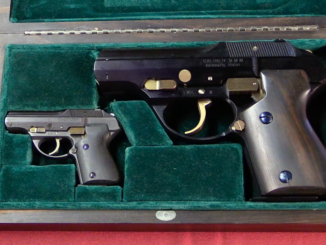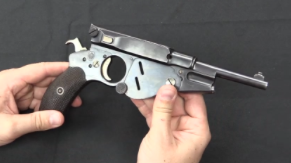This submachine gun is lot #1011 in the upcoming April 2019 Morphy auction.
The MP-35 is one of several very nicely made inter-war German submachine guns. Unlike most, it has the magazine mounted on the right, and ejects out the left – a configuration chosen to standardize the manual of arms with the K98k style bolt handle. The MP-35 is also unusual in having a progressive type of trigger – although it’s not really a normal progressive trigger even. Instead, it is a normal sort of trigger for semiautomatic fire, and a second lever below the trigger which must be pulled for full auto fire. I suspect this will take a bit of getting used to…




Finely made gun, no doubt. The uninitiated ones would think than the British were the only purveyors of this concept, which they were not.
Doing all the ancillary operations by ‘trigger’ hand was natural to me during my training and still remains to be. So much more strange was finding that the N/A practise was the opposite. To this day I do no understand why ‘normal’ aka R.H. person reaches over to AK/vz.58 charging handle with his left hand.
Bergmann advertised his sub-machine gun, see 1st image from top:
https://modernfirearms.net/en/submachine-guns/germany-submachine-guns/mp-35-bergmann-eng/
as
Die technisch vollendete
Kleinmaschinenwaffe
– vielfach patentiert –
which might be translated as Technically perfet small machine weapon – multiply patented. Note that for some reason, already established term Maschinenpistole was not used.
Oops… actually there is Maschinen-Pistole in title. I need to be more careful.
Using trigger hand to operate important controls also prevents accidental friendly fire during reloading, assuming everyone points weapons down range before racking the bolt or putting a finger near the trigger. Otherwise we get “Oh no, I just shot Alfred in the knee!” The popular “Hollywood reload,” with the off hand doing the reloading and bolt charging on long arms, stems more from looking cool and purportedly being faster in terms of getting back to shooting, as is depicted with any weapon with left-sided charging handles. I am certain that a few discharge accidents occurred with the MP-40 and the MP-44 when the other team got a bit too personal.
Quite correct; I never though about it before.
“Finely(…)”
Actually MP.35 was simplified version of Bergmann-Maschinen-Pistole Modell 1932.
“(…)uninitiated ones would think than the British were the only purveyors of this concept, which they were not.(…)”
Actually they were replicators (I hope it is correct word) in regard of 1st generation sub-machine guns. And also somewhat… late to party, with no sub-machine gun introduced to service 1930s. That being said, other nations even if used sub-machine gun, then it was on limited scale, so high-price was acceptable.
“Replicators”…? Yes, I would say so. Their first Bergmann-like SMG was Sterling, unwieldy and heavy with receiver out of navy bronze
https://en.wikipedia.org/wiki/Lanchester_submachine_gun
Perhaps I should be less harsh on Lancaster. As Wiki says in following description:
“It was a very solid, well-made submachine gun of high quality materials, in many ways the complete opposite of its direct contemporary, the Sten.”
The British had generally meticulous approach to construction of mechanical devices, as their motorcycles from same period plentifully testify.
“should be less harsh on Lancaster”
Lanchester (machine carbine) not Lancaster (4-engine bomber of same era). It was copycat design, so performance similar to original is what should be excepted.
The British were eventually looking at the Suomi, but events overtook the military procurement heirarchy, hence the Lanchester copy of an Erma.
But yes, like a lot of things (eg, submarines and torpedoes, hand to hand combat that didn’t follow marquis of Queensbury rules) SMGs were seen as ungentlemanly gangster weapons, with no place in a civilised country.
In Churchill’S (horrible psychopathic narcissist impo) autobiography of his early life, he said that grenades were considered to be totally obsolete, In his training as a cavalry officer.
“grenades were considered to be totally obsolete”
Many various weapon and other equipment have come-back to fields of Great War, beyond grenades, mortars and various bludgeoning weapons (maces e.t.c.) comes to my mind, though possibly most visible revived piece of equipment was steel helmet.
I wonder if the idea was to discourage the (mostly right handed) firer from holding the magazine.
For another sub-machine gun with magazine sticking to right see https://modernfirearms.net/en/submachine-guns/switzerland-submachine-guns/wf-lmg-pist-4144-eng/
Quite possibly so. Generally, it is no desirable to hold automatic weapon by magazine since it can affect feeding.
I would say that magazine-weapon interface need special care during designing if magazine is supposed to be used in lieu of grip. Note that for example PPSh manual shows that for certain situations correct method is placing left hand at lowest point of drum magazine.
Full manual is here: http://guns.allzip.org/topic/18/152004.html (click to enlarge)
Interesting in this context:
http://img.allzip.org/g/18/orig/410424.jpg (drawing 63)
http://img.allzip.org/g/18/orig/410426.jpg (drawing 66, right half)
“no desirable to hold automatic weapon by magazine”
Apparently this was cause for moving magazine from left to right in SIG 1930:
https://modernfirearms.net/en/submachine-guns/switzerland-submachine-guns/sig-1920-1930-eng/
additionally forward grip was added.
“standardize the manual of arms with the K98k style bolt handle”
Not so fast. Bergmann-Maschinen-Pistole Modell 1932 manual indeed claims that cycling is familiar to bolt-action repeating rifle, but it says “Gewehr 98” NOT K98k which did not existed until 1935. Said manual also note another positive effect of that solution – unlike MP.18 there is not opening in which bolt handle ride, therefore “foreign bodies” (dirt e.t.c.) could not go inside that way.
Also: release that in 1932 any shoulder weapon that has a “selector switch” would require some new training – what is this weird new thing “selector switch?”
Bergmann-Maschinen-Pistole Modell 1932 manual claims that thanks to no need of actuating lever or another thing, ammunition will be preserved. Allows usage of full-auto only to targets requiring that.
Empties come through the door like little gentlemen, and quietly take their seats on the ground. That would be welcome on the range, with somebody close by to your right.
See also: The Owen SMG!
Those of us who grew up with the L1A1 / SLR / “Inch” FAL learned early that the concept was that the “master” hand did not leave the pistol grip. The “other” hand did all the frilly bits like cocking, changing mags, sight adjustment, holding the fore-end, etc.. A bit tricky for “south-paws”, but it is not a challenge to operate the selector without significant movement of the hand on the grip.
The “imediate action” drill, when the rifle stopped working was simple: TILT (the file so that the ejection port was dtowards the groung), COCK (theh weapon with the non-master hand), LOCK the working parts to the rear, using a finger extended down to raise the bolt hold-open) and LOOK (rotate the weapon so that the ejection port is uppermost and the chamber clearly visible. At night, a poke into the chamber with a small finger of the “non-master” hand is required. Also, in daylight, look at the ground below the weapon to see what, if anything, was ejected; hence the rotation to eject DOWNWARDS).
The “master” hand was also in charge of operating the selector, which is why the L1A1 has a bigger, more ergonomically-shaped device than the original FAL.
Bruce:
These drills made a lot of sense for the SLR, which had its charging handle on the left. Unfortunately, they have been maintained for the SA80 series, where the charging handle is on the right. It would make more sense with the SA80 to operate the charging handle with the right hand, but instead troops are taught to keep the right hand on the pistol grip, tilt the rifle over, and charge it with the left hand. Since it is a bull pup, the charging handle is further back than on an SLR, and the whole process looks awkward and slow. Since soldiers are trained to do as they are told, and since there is no way for a British soldier to have gained any experience on any other modern rifle in civilian life, I think soldiers go along with this, without questioning it.
And then they’ll get smashed when someone else shows up with a more practical personal weapon that won’t require a full minute to reload!
Cherndog:
Sadly, that is correct. We are lucky that most of the opponents we have been facing for the last several years have been largely untrained militias, so the failings in our manual of arms are not too apparent. This may not always be the case.
This gun is probably (way?) more accurate in semi auto than most other open bolt submachineguns, as the bolt in cocked state is not far away from the breech, as we can easily see.
But in full auto it is maybe too fast, and chews through mag in no time.
“But in full auto it is maybe too fast”
According to Bergmann-Maschinen-Pistole Modell 1932 manual cyclic Rate-of-Fire is about 700…800 rpm.
“chews through mag in no time”
Keep calm according to Bergmann-Maschinen-Pistole Modell 1932 manual, one of novelties and improvements over M.P. 18 is that you could load 32 cartridges into magazine just with your fingers (no need for special device), also one of accessories sold together with sub-machine gun is special formed piece of metal (no moving part) allowing loading magazines from 10-round strippers. (This is possibly another blink to Gewehr 98 users – loading magazines from strippers, though in case of sub-machine gun it was loading of magazine detached).
I’d say on the video rof is at least 850, maybe even 900 rpm. Bolt is heavy but also very long, so it bottoms out fast.
Yeah, having double feed mag is extremely beneficial compared to mp40 or Sten single feed, if they were too smart they would have adopted it in mp40.
My opinion is, based on the quirky trigger and users (police etc. no military units) that this smg is constructed with precise semi auto fire in mind (also why there are rifleish bolt action features),
and full auto was just a secondary option.
“at least 850, maybe even 900 rpm”
If this is true that suggest that authors of Bergmann-Maschinen-Pistole Modell 1932 manual used somewhat milder loading of 9×19 Parabellum cartridge.
“users (police etc. no military units)”
Bergmann-Maschinen-Pistole Modell 1932 manual gives technical data for 9×19 Parabellum cartridge and inform it is also available for following cartridges:
Bergmann 9 mm [i.e. 9×23 Largo]
Mauser 7,63 mm
Browning 9 mm lg. [i.e. 9×20 SR Browning]
Colt 0,45 [i.e. .45 ACP]
This suggest export market was considered important by its makers, as some of these cartridge were minimally popular in 1930s Germany.
Finally, a gun suited for the likes of gun Jesus, rumor has it the interwar Germans had him in mind when designing some of the weird features present on the mp35